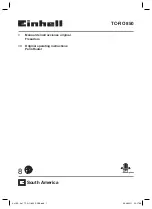
1045
Troubleshooting
Information for Troubleshooting
The
traceroute mac ip
command output shows the Layer 2 path when the specified source and destination IP
addresses belong to the same subnet. When you specify the IP addresses, the switch uses the Address Resolution
Protocol (ARP) to associate the IP addresses with the corresponding MAC addresses and the VLAN IDs.
—
If an ARP entry exists for the specified IP address, the switch uses the associated MAC address and identifies
the physical path.
—
If an ARP entry does not exist, the switch sends an ARP query and tries to resolve the IP address. If the IP
address is not resolved, the path is not identified, and an error message appears.
When multiple devices are attached to one port through hubs (for example, multiple CDP neighbors are detected on
a port), the Layer 2 traceroute feature is not supported. When more than one CDP neighbor is detected on a port,
the Layer 2 path is not identified, and an error message appears.
IP Traceroute
You can use IP traceroute to identify the path that packets take through the network on a hop-by-hop basis. The
command output displays all network layer (Layer 3) devices, such as routers, that the traffic passes through on the way
to the destination.
Your switches can participate as the source or destination of the
traceroute
privileged EXEC command and might or
might not appear as a hop in the
traceroute
command output. If the switch is the destination of the traceroute, it is
displayed as the final destination in the traceroute output. Intermediate switches do not show up in the traceroute output
if they are only bridging the packet from one port to another within the same VLAN. However, if the intermediate switch
is a multilayer switch that is routing a particular packet, this switch shows up as a hop in the traceroute output.
The
traceroute
privileged EXEC command uses the Time To Live (TTL) field in the IP header to cause routers and servers
to generate specific return messages. Traceroute starts by sending a User Datagram Protocol (UDP) datagram to the
destination host with the TTL field set to 1. If a router finds a TTL value of 1 or 0, it drops the datagram and sends an
Internet Control Message Protocol (ICMP) time-to-live-exceeded message to the sender. Traceroute finds the address
of the first hop by examining the source address field of the ICMP time-to-live-exceeded message.
To identify the next hop, traceroute sends a UDP packet with a TTL value of 2. The first router decrements the TTL field
by 1 and sends the datagram to the next router. The second router sees a TTL value of 1, discards the datagram, and
returns the time-to-live-exceeded message to the source. This process continues until the TTL is incremented to a value
large enough for the datagram to reach the destination host (or until the maximum TTL is reached).
To learn when a datagram reaches its destination, traceroute sets the UDP destination port number in the datagram to a
very large value that the destination host is unlikely to be using. When a host receives a datagram destined to itself
containing a destination port number that is unused locally, it sends an ICMP
port-unreachable
error to the source.
Because all errors except port-unreachable errors come from intermediate hops, the receipt of a port-unreachable error
means that this message was sent by the destination port.
TDR
You can use the Time Domain Reflector (TDR) feature to diagnose and resolve cabling problems. When running TDR, a
local device sends a signal through a cable and compares the reflected signal to the initial signal.
TDR is supported only on 10/100 and 10/100/1000 copper Ethernet ports. It is not supported on SFP module ports.
TDR can detect these cabling problems:
Open, broken, or cut twisted-pair wires—The wires are not connected to the wires from the remote device.
Shorted twisted-pair wires—The wires are touching each other or the wires from the remote device. For example, a
shorted twisted pair can occur if one wire of the twisted pair is soldered to the other wire.
If one of the twisted-pair wires is open, TDR can find the length at which the wire is open.
Summary of Contents for IE 4000
Page 12: ...8 Configuration Overview Default Settings After Initial Switch Configuration ...
Page 52: ...48 Configuring Interfaces Monitoring and Maintaining the Interfaces ...
Page 108: ...104 Configuring Switch Clusters Additional References ...
Page 128: ...124 Performing Switch Administration Additional References ...
Page 130: ...126 Configuring PTP ...
Page 140: ...136 Configuring CIP Additional References ...
Page 146: ...142 Configuring SDM Templates Configuration Examples for Configuring SDM Templates ...
Page 192: ...188 Configuring Switch Based Authentication Additional References ...
Page 244: ...240 Configuring IEEE 802 1x Port Based Authentication Additional References ...
Page 298: ...294 Configuring VLANs Additional References ...
Page 336: ...332 Configuring STP Additional References ...
Page 408: ...404 Configuring DHCP Additional References ...
Page 450: ...446 Configuring IGMP Snooping and MVR Additional References ...
Page 490: ...486 Configuring SPAN and RSPAN Additional References ...
Page 502: ...498 Configuring Layer 2 NAT ...
Page 770: ...766 Configuring IPv6 MLD Snooping Related Documents ...
Page 930: ...926 Configuring IP Unicast Routing Related Documents ...
Page 976: ...972 Configuring Cisco IOS IP SLAs Operations Additional References ...
Page 978: ...974 Dying Gasp ...
Page 990: ...986 Configuring Enhanced Object Tracking Monitoring Enhanced Object Tracking ...
Page 994: ...990 Configuring MODBUS TCP Displaying MODBUS TCP Information ...
Page 996: ...992 Ethernet CFM ...
Page 1066: ...1062 Using an SD Card SD Card Alarms ...
















































